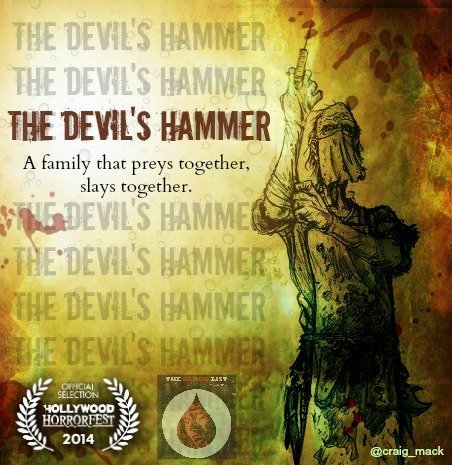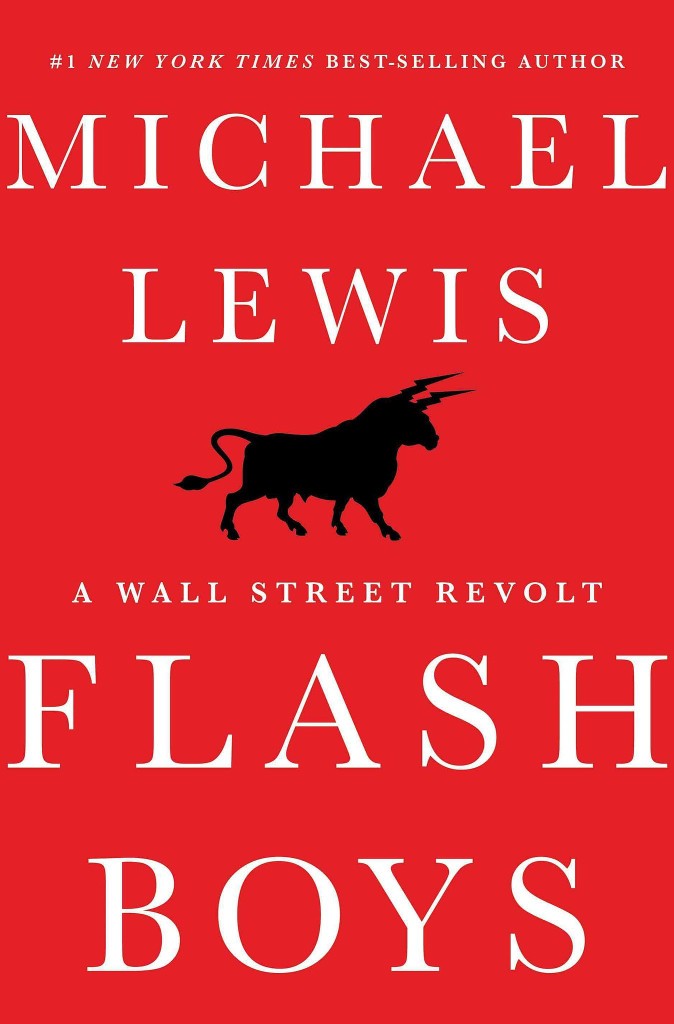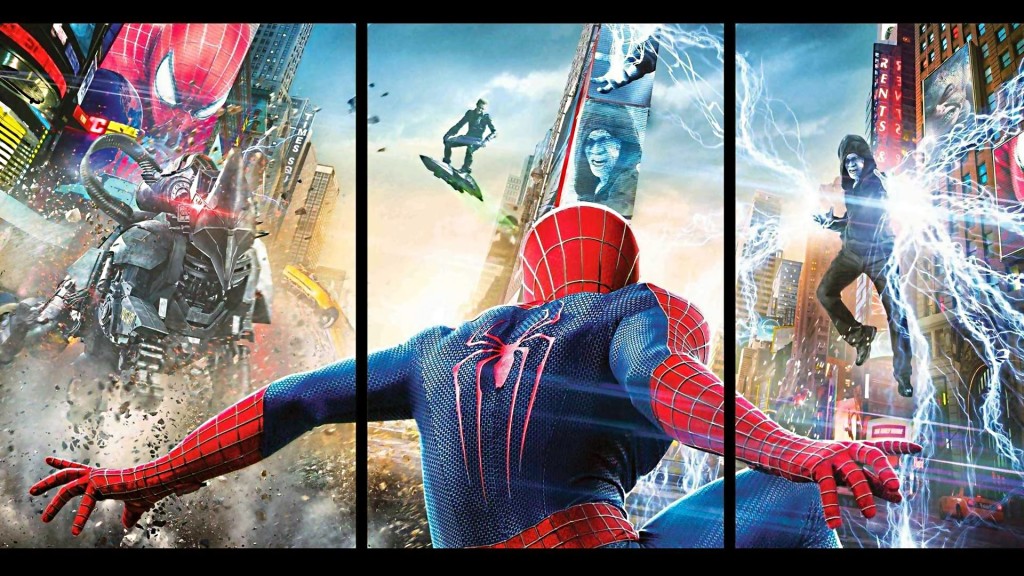Get Your Script Reviewed On Scriptshadow!: To submit your script for an Amateur Review, send in a PDF of your script, along with the title, genre, logline, and finally, something interesting about yourself and/or your script that you’d like us to post along with the script if reviewed. Use my submission address please: Carsonreeves3@gmail.com. Remember that your script will be posted. If you’re nervous about the effects of a bad review, feel free to use an alias name and/or title. It’s a good idea to resubmit every couple of weeks so your submission stays near the top.
Genre: Horror
Premise (from writer): When an outlaw biker, and soon to be father, attempts to leave the sins of his old life behind, he is pushed by a vengeful Sheriff into the arms of an ancient cult of disease worshiping sadists.
Why You Should Read (from writer): The Devil’s Hammer recently won the Top Unproduced Screenplay Award at the Hollywood Horrorfest, Bloodlist Approved, a finalist in the Famous Monsters Film Fest. The Devil’s Hammer is a horror fan’s horror movie. It’s a throwback to the days of Craven, Barker, Raimi with the modern flair of Roth and Zombie. It preys on the primal fears of loss of control and disease. It’s visually gut wrenching, suspenseful and action packed.
Writer: Craig Walendziak
Details: 96 pages
The Devil’s Hammer got a lot of love from the Amateur Offerings Audience a couple of weeks ago. And the fact that the writer went to Harvard didn’t hurt. Those Ivy League credentials are enough to get someone to at least OPEN your screenplay. But that’s not the only thing noteworthy about today’s writer. Craig claims this is his first script! And while I haven’t read it yet (I will start as soon as this intro is over – I like to get kooky occasionally), I’m already impressed. You’ve got to have some pretty raw talent to get this many people excited over a first screenplay.
The best news is I’m in the perfect condition to read “Hammer.” It’s 3 in the morning, I just watched the first episode of Catfish, this is my fourth script read of the day, and I’m pretty sure when I asked for shrooms on my pizza, they didn’t include the kind you get at the grocery store. So I’m a little bit wired at the moment. On nights like this, scripts can turn into fried cheese balls with wings. Time to fly away!
The Devil’s Hammer is not that original (even the writer concedes this). It starts with the traditional horror teaser, where a couple of characters (in this case, bikers) get in an accident out in the middle of nowhere, and are soon surrounded by a bunch of dudes in hooded robes. Unless someone is saying “the force is with you,” dudes in hooded robes are NEVER good. I repeat: NEVER take candy from dudes in hooded robes.
After that, we meet a big biker gang. They ride around a lot, doing a bunch of unsavory things. I haven’t seen Sons of Anarchy but I’m guessing these folks cover the same territory. Today, however, they’re just enjoying themselves, drinking some brews at the bar. The key players are Jimmy, who’s planning to leave the group for the straight life, Davie, a huge man who doesn’t think Jimmy should leave, “Wheels,” the young player of the group, “Blitz,” packed with energy, and Maggot, the long-standing vet.
As the men drown themselves in nature’s yeast, the Sheriff and his deputies show up. A little backstory here. The sheriff thinks this gang killed his brother (they didn’t, he’s the one taken by those hooded men in the opening scene, which he shouldn’t have done, because, say it with me, “You never take candy from men in hooded robes unless they can teach you the force.”). One thing leads to another, a huge gunfight ensues, and our core bikers make a run for it. With Maggot injured and bleeding out, they need to find help for him quickly. And where do they end up? An old mining town deep in the forest up in the mountains.
It’s not long before we learn the occupants of this town are those hooded jerkhead jedi impersonators. And that the reason they wear hoods is to hide their horribly diseased faces (which contain boils, tumors, warts, pox, lesions, you name it). So yeah, they’re not e-mailing headshots to the latest America’s Top Model cycle in their spare time. Or if they are, they’re getting a very low response rate.
Before our gang realizes these diseased wackos are bad, most of them are tied up and helpless. Around this time, the sheriff infiltrates the town as well, but figures out quickly that once Merriwhether and his band of Black Plague pals get you here, you’re at a severe disadvantage.
From there, things naturally descend into chaos. In one scene, one of our men is tied up on a basement hospital gurney, thinking he’s about to be stabbed with a knife. But no. The diseased dude reaches up to his face and slits the knife through all his boils and tumors and lesions, collecting the drooling pus into a glass and inserting it in our biker’s wound, ensuring he’ll be diseased as well (I thought he was going to make him drink it actually – now THAT would’ve been a scene).
It then becomes a life or death situation where our guys have to not only get the hell out of here, but get out of here without getting infected. The chances of that happening are about as good as James Franco posting a fully-clothed selfie.
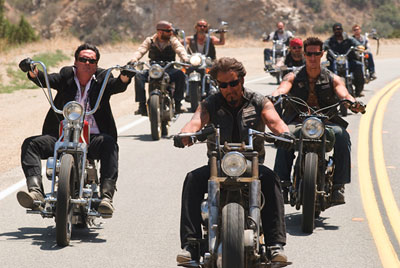 “Excuse me. We’re looking for a run down town of pus-filled rotting sadists. Is that up past the Waffle House?”
“Excuse me. We’re looking for a run down town of pus-filled rotting sadists. Is that up past the Waffle House?”
The truest test of a script is, would you pass it along to someone else? Do you care about it enough to go out of your way and recommend it to others? Here’s the thing with The Devil’s Hammer. I’m not sure I would recommend this to others on the strength of the script. But I would recommend it to producers who want to make a good horror movie. I’m 90% sure somebody will option/buy this and that it will get made. It’s just a slam dunk from a marketing perspective. It’s familiar (a Chainsaw Massacre meets House of Wax setup) and it has something a little different going for it that’ll keep the kids squirming in their seats.
And it’s got some really memorable scenes as well. There’s a scene where two of our players are tied up in a room full of children who play a game of “jack-in-the-box” torture, winding the jack-in-the-box one rotation at a time. Whoever gets the jack out of the box gets to torture one of their captives, usually via something like pulling off their finger nails with a set of pliers (That’s a lot different from my game of jack-in-the-box, which consists of trying to figure out why the meat inside the 2 tacos for 99 cents is so soupy).
There’s the fucking grandma character, who absentmindedly plays a creepy endless tune on the piano. When we get close enough to her, though, we see that her body is covered in huge tumors. The one on the left side of her face is so big, it weighs her head down in that direction. She doesn’t even have eyes because the tumors have pushed them closed.
And the church. Wow. I’m not going to spoil it here, but I’m not sure I’ve ever been as horrified by an image on paper as what’s in that church. That’s going to leave a lasting memory for all who witness it.
But what about the STORY! Well, it’s not bad, but it’s not as good as it could be. The thing with this kind of movie is, the script doesn’t have to be perfect. I hate saying that, but as long as you’re inventive with the terrifying world you’ve set up – which Craig is – that’s what matters most. It’s not the same kind of horror as, say, The Ring, which requires clever pacing, solid twists and turns, and well-drawn characters. This is more shock-horror.
I definitely think Craig could do more with his characters though. There’s nothing really going on with any of them. And the ones where there is something going on, it’s not clear what that “on” is. Like Jimmy and Davie. Davie was really mad at Jimmy, but I couldn’t figure out why. It was either because Jimmy was leaving the group or because of something Jimmy did in the past.
Also, I didn’t understand what this biker gang did. Were they a band of criminals, or just really rowdy bikers?
Then there was the Sheriff’s pursuit of them. The Sheriff is informed by the bartender that the bikers are at the bar, which seems to imply that this is the only chance the Sheriff will have of catching them. Except this is the year 2014. All you need is Google to find out where people live. How come he has to wait for them to come together at a bar before he can find them?
Then there’s his plan. The best thing he can think of to catch a band of armed bikers is wait for them to get into a bar, barge in, start a shootout, and hope he’s able to kill them all? That not only seems illegal, but really dumb.
Then, once our bikers get to the town, something was off. It took me awhile to figure out what it was, but I eventually realized I wasn’t scared for our characters. And the reason I wasn’t scared was because they were all so capable. These were tough bikers with guns. They were used to handling themselves.
That’s why horror movies usually center around physically weak protagonists. Young women. Mothers. Mothers and their children. Teenagers. These are people who are up against a stronger enemy, which is why you’re afraid for them. With bikers, even when they were caught, I figured they’d get out of it. They were all just too strong.
With that said, I’m not sure I’d switch the bikers out for weaker protagonists. The biker angle is part of what makes this unique. But maybe try to be more convincing on how these weak diseased dudes are able to so casually defeat the bikers. Maybe they’re smarter than the bikers. They use their intelligence and home field to trick them. But if it comes down to blunt strength, come on. The bikers are going to win every time.
Finally, there isn’t a clear-cut hero here. Not that that’s a requirement, but it sort of is. We need to know who’s leading the charge. At first I thought it was Jimmy, since we start with him, but Jimmy’s actually pretty boring. It’s Davie who actually gets the most screen time. If I were Craig, I’d look to make Jimmy the clear-cut hero and give him the depth that a clear-cut hero needs in a story. Leaving a pregnant girlfriend at the beginning of the script isn’t enough. He needs a flaw, something he’s fighting on the inside. Maybe it’s his fear to commit to this woman. He’s struggling with whether he wants to settle down or not (instead of it being a foregone conclusion). I don’t know. Maybe some of the commenters can give you ideas. But if you’re going to play with the big boys, you gotta learn to create depth in your characters.
With all that said, I think there’s more good here than bad. And I think the good things are so good, that they make you forget about a lot of the mistakes. Don’t get me wrong, I’d like for those mistakes to be fixed as well. But The Devil’s Hammer delivers what its customers want. And if you have that, you have a script that can sell.
Script link: The Devil’s Hammer (latest draft)
[ ] what the hell did I just read?
[ ] wasn’t for me
[x] worth the read
[ ] impressive
[ ] genius
What I learned: Every scene here was a fresh variation on scenes I’ve seen before. Where genre writers get it wrong is they write COPIES of their favorite scenes. Don’t copy. Start from the same place, but then challenge yourself and look for ways to make the scene yours. I’ve seen basement hospital scenes before. I haven’t seen one where a guy cuts his sores and lets the pus drip into a glass and then pour it into our character’s wounds. I’ve seen the creepy woman playing the piano from behind before. I haven’t seen it where the woman has tumors the size of basketballs all over her body. I’ve seen freaky kids scenes before. I haven’t seen one where pus-filled diseased looking kids play a jack-in-the-box torture giggle game. It’s when I see these variations on scenes that I know the writer is above and beyond the typical amateur.
What I learned 2: You probably shouldn’t tell somebody this is your first script (or 2nd, or 3rd). They’ll be looking for first-time mistakes throughout, and rarely give you the benefit of the doubt. Trust me, you want as much benefit of the doubt as you can get in a read.
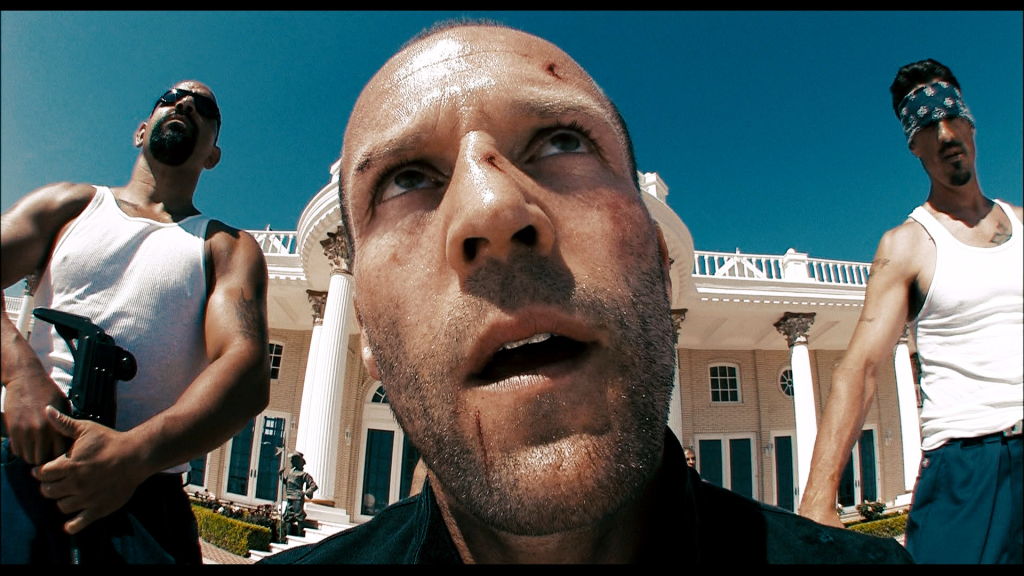 Jason Statham fully endorses #3
Jason Statham fully endorses #3
It’s one of the questions that never goes away for a writer. What should you write next? Write what you know? Write what you want? Write what’s going to make money? I don’t think there’s any one right answer. I’ve seen writers break in with a script they’re passionate about (Allan Loeb: “Things We Lost In The Fire”) and writers break in with a script that was purely market-driven. Ideally, the stuff you want to write would match up with the stuff that Hollywood wants to make, but it never quite works out that way, does it?
Then again, maybe you haven’t explored all your options yet. Maybe you need to see all those options to make an informed decision. That’s what inspired today’s post. I thought it’d be fun to show you the top ten types of movies Hollywood likes to make. These are the movies that keep popping up, year after year, and have been making the film industry moolah for decades. If you’re not writing within one of these genres, you’re not necessarily screwed, but you certainly aren’t making things easy on yourself.
A couple of caveats to this list. I don’t want to include anything that’s impossible for the average amateur screenwriter to write. So I’m not going to include comic book movies, high profile intellectual properties (Harry Potter, Twilight, The Hunger Games), or animated films. I’m also not including sub-genres that pop up every five years or so, stuff like submarine flicks, the body-switching movie, the inspirational-teacher movie, or the stoner-comedy. The whole point of this list is to show the TOP films that Hollywood likes to make year in and year out. Let’s take a look, shall we?
1) The buddy cop comedy – This sub-genre doesn’t need much of an explanation. Basically, pair two people up who have a job to do, make sure there’s a lot of conflict between them, and make sure it’s damn funny. This year it was Ride Along. Last year it was The Heat. Before that 21 Jump Street. The Other Guys. Going back in history, we had Rush Hour, 48 Hours, and Lethal Weapon.
2) The weepy romance – Destined to drive men everywhere mad, the weepy romance flick is primed for the young female audience to drag their boyfriends to. It’s recently been dominated by the Nicholas Sparks craze, but it’s been around much longer than that. I guess not surprisingly, these movies almost always have someone dying in them. The Fault In Our Stars, Love Story, Harold and Maude, The Notebook, The Last Song, The Lake House. Strange how soft and soothing all those titles sound. These films don’t do Transformers numbers, but they bring in the lady money.
3) The straight action thriller – These are usually very simple stories following a bad ass protagonist as he/she kicks a lot of ass in pursuit of a clear goal. Die Hard, Brick Mansions, Jack Reacher, Salt, James Bond, Wanted, Crank, Rambo. Liam Neeson has made this genre his bitch in recent years, but it’s been around long before him and will continue to be around long after.
4) The big action movie where shit gets destroyed – It could be aliens, monsters, zombies, whatever. Give us a movie big in scope where lots of shit gets effed up. World War Z, Independence Day, Godzilla, Pacific Rim, Cloverfield, War of the Worlds, The Day After Tomorrow, Battle L.A. Hey, where else can anyone destroy entire cities with just their MacBook. This is one of the coolest things about being a writer!
5) The safe female-driven comedy – This is an area where Hollywood has changed. This slot used to go to the classic romantic comedy, stuff like The Wedding Planner or Notting Hill. Now, these stories tend to be broader in scope with multiple characters. For the most part, the female audience who go to these movies want to watch female characters going through the same things they are, and laugh about it. The Other Woman, Sex and the City, Eat Pray Love, Julie and Julia, He’s Just Not That Into You, Mamma Mia. If you’re a man writing these movies, God help you with authenticity.
6) The classic high concept comedy – This genre is never going away. If you can come up with a clever big idea for a comedy, you can strike gold in the spec market and at the box office. High concept comedies are one of the few genres that can break through that stodgy box office top 10 full of sequels, cartoons, and comic books. The Hangover, We’re The Millers, Identify Thief, Night at the Museum, Tropic Thunder.
7) The action-adventure – Although increasingly difficult to break into this IP dominated field, if you can write a good one (which, by the way, usually requires its characters to wield swords, wear sandals, or both), you can start yacht shopping, because these don’t just make a lot of money HERE. They make a lot of money EVERYWHERE, as in all over the world. Pirates of the Caribbean, Braveheart, 300, Troy, Raiders of the Lost Ark, Immortals.
8) The big family comedy – One of the few huge genres you don’t need intellectual property for. These movies are usually divided into two categories – the literal family adventure, and the unique concept targeted at families. In the first category you have stuff like Cheaper by the Dozen, Parental Guidance, Blended and RV. And on the other end, stuff like The Tooth Fairy, Beverly Hills Chihuahua, Journey to the Center of the Earth, and Home Alone.
9) The straight horror film – This is a tricky one. Hollywood loves these films cause they cost so little to make and have such a big upside, but they’re more of a crapshoot than they look. Maybe you get the next Paranormal Activity. But there’s a much better chance you’ll get Would You Rather. Your best bet is to focus on a unique concept that you haven’t seen before, then write in the most complex characters you can. No character development in a horror script almost always leads to direct-to-Itunes. The Conjuring, The Sixth Sense, Oculus, Saw, The Exorcist, The Shining.
10) The serious subject matter vanity project – These are usually centered around the most complex characters of the year. So don’t even attempt to write one if the main character isn’t fascinating in some way. Also, they’re almost always based on real people, so you’ll typically have to snatch up the rights to someone in book or article form. Not as impossible as you might think. Sure, you’re not going to get the big players, like Johnny Cash, but there are plenty of people in this world who have lived captivating lives that haven’t had movies made about them yet. Other than that, this sub-genre is exactly what it sounds like. Write us a story centered around a very compelling individual that has the potential to win an actor an Oscar. The Wolf of Wall Street, The Aviator, Lincoln, Seven Pounds, Ray, A Beautiful Mind.
So why are these movies so popular? Well, outside of the obvious, that audiences enjoy them, these are the movies Hollywood knows how to market best. They know exactly how to draw up the posters, how to cut the trailers, how to snip together a TV spot. That makes them low-risk, and since Hollywood is risk-averse, that’s a match made in heaven. But it doesn’t mean if you’re not writing one of these that you’re screwed. Plenty of popular films don’t fall into these categories. Life of Pi, The Descendants, Argo, Magic Mike, Gravity, American Beauty, Slumdog Millionaire.
The difference is, because Hollywood knows these movies are going to be tougher to market, they’re less inclined to pick them up or produce them. Which simply means the journey to get your script purchased or made will be harder. As long as you know that and are okay with it, by all means take that chance (although you should be taking less chances the older you get). I believe your best shot at success is to look through the ten film types I’ve listed above, figure out which one you like best (the kind of film you actually go out and pay for) and see if you can’t write something in that mold. Not a copy. But a fresh angle that gives the genre a kick in the butt. That way you get the best of both worlds. You get to sell your script to Hollywood and you get to push the envelope some. I’ll be right here on the other side waiting to see what you come up with. ☺
Genre: Non-Fiction Book
Premise: A group of Wall Street underdogs begin to realize that the current computer-driven stock market is rigged, and decide to do something to change it.
About: Everyone in town takes notice when Scott Rudin options something, because Scott Rudin wins Oscars. He’s the guy who headed up The Social Network, after all. So when he snatched up Michael Lewis’s best-selling non-fiction book, Flash Boys, the book immediately hit everyone’s radar. You probably know Lewis best for writing the book Moneyball, which, of course, eventually became the movie starring Brad Pitt. You can find Flash Boys here (and as long as you’re over at Amazon, you should pick up my book too. It’s only $4.99!).
Writer: Michael Lewis
Details: 289 pages (published March 31, 2014)
We’re going to do something a little different today. Once that glorious moment comes when you break into Hollywood (through a spec sale or just by writing a great script), your ability to stay in the club will depend on your ability to land assignments. You’ll have to read books like Flash Boys, then come in and pitch your take to producers.
You’ll be up against lots of other writers, so your pitch is going to have to be good. And when I say, “pitch,” I don’t mean your showmanship ability. That’s important, of course. But what’s more important is your take. How do you plan to tell the story?
Because the reality is, a lot of things you’ll need to pitch won’t be obvious stories. They won’t have that perfect narrative spine of a main character going after something and encountering obstacles along the way. In those cases, you’ll need to find a spine. Or decide if you even want a spine. Maybe you want to try something different? The Social Network, the way it bounced back and forth between the deposition and genesis of Facebook, wasn’t a straight-forward treatment of a story at all.
Take Flash Boys. While the characters eventually do come up with a goal, it isn’t until much later. At first, this book is all about numbers and equations and stocks and how stock exchanges work and individual stories of how this rag-tag team of men came together to fight the power. Then, it’s almost like Lewis realized, “Oh yeah, I have to bring this all together,” and came up with something for the group to do.
Flash Boys actually starts with the most fascinating story in the book. A man is secretly building a fiber optic line between Chicago and New Jersey (where the major stock exchanges in the country are located). But this isn’t any ordinary line. He needs it to be straight. Like perfectly straight.
You see, in recent years, trading stocks has become a game of speed. How much speed? The kind of speed where if you can gain at least 1 millisecond over your competitor, it could be worth hundreds of millions of dollars. How is that even possible? That’s what much of the book is about.
But anyway, what this guy realized, was that the current fiber optic line that travels between New Jersey and Chicago zig-zagged all over the place. He hypothesized, that if he could build a straight line, he could save stock traders up to 7 milliseconds of time, which would allow them a huge advantage over their competition.
So his plan was to build this secret line, then go to all the biggest banks and mutual funds and traders, and basically hold them hostage. He’d tell them that if they didn’t get on this line, their competition was going to smash them. Everyone would have to join, and he’d be able to set the price. What would that price be? 10 million each. And guess what? They all signed up.
If there’s a hero in this story, it’s probably Brad Katsuyama. Brad worked for the biggest bank in all of Canada, but when his bank opened a branch in New York, which he’d eventually move to, he realized that nobody gave a shit. On Wall Street, the biggest bank in Canada was the equivalent of a hot dog stand outside of Mcdonalds.
Brad’s new branch meant the company needed a new trading operating system, one that could compete with the heavy hitters on Wall Street. But while Brad expected this new system to make his work easier, it actually did anything but.
Brad realized that whenever he made a trade on this new system, everything in the market would immediately change. Prices in that stock would shoot up or shoot down instantaneously, making it impossible to track the market on any sort of consistent level. In short, every time Brad would make a trade, chaos would ensue.
And he learned he wasn’t alone. When he’d go to other companies, he found that the same thing was happening to them. The crazy thing was, nobody knew why it was happening. Everyone just assumed that because technology was increasing at such a rapid rate, chaos was the collateral damage.
But Brad wasn’t so sure. He thought something fishy was going on. So he went to all the guys at all the top banks and all the top firms, asking them what they thought was going on. But nobody had a clue. What confused Brad is that nobody was that concerned about it either. Something nefarious was clearly going on inside the biggest financial machine in the world, and everyone either didn’t care or didn’t want to spend the time trying to figure it out.
Finally, Brad figured it out. The problem was High Frequency Traders. Now the book gets REALLY specific about what these guys do, which is super complicated, but I’ll try to simplify. Basically, these lone shark dudes figured out a way to see when one of these huge banks or companies was making a trade, then would zip in and buy or sell in order to profit off of it. They could make millions a day doing this. And every time they took that money, it meant the banks and hedge funds were losing it. And whose money do the banks and hedge funds use? YOUR money. So these guys were stealing from YOU.
How did they do it? SPEED. A bank may buy tens of thousands of shares of stock in one go. That takes time. And by time I mean seconds. But if a high frequency trader (HFT) has access to one of those connections that can make a trade in 7 milliseconds, they can buy and sell stocks before your order has even finished going through.
This is why speed became such an important commodity on Wall Street. Whoever had the fastest connection, even if it was by just .1 millisecond, they could undercut you. So HFT were willing to pay millions for those milliseconds.
Awhile back, you’d hear stories about how traders would have their routers set up in the building right next to the Exchange that made all the trades. This allowed them to make their trades the fastest. Savvy entrepreneurs figured this out, would buy up these adjacent buildings and sell router space INSIDE the rooms in the buildings.
But even that wasn’t enough after awhile. Traders would start paying money to get preferred placement INSIDE the room. They wanted their routers to be right next to the wall, so they were closest to the trading building across the street. Even if it was just .1 microseconds of an advantage, it was an advantage.
The book covers how Brad figured all this out, along with his campaign for trying to explain to Wall Street how badly they were getting screwed. Nobody believed him though because nobody on Wall Street gives you information for free. They erroneously figured he must be trying to scam them. Nobody just tells you how to save money. They use that information to MAKE money. They didn’t realize that Brad was just Canadian.
After his knowledge campaign failed, Brad decided to do something unprecedented. He recruited a bunch of underdogs that Wall Street had spit out, and decided to create a new stock exchange. This exchange would have a built-in algorithm that would make it impossible for high frequency traders to game the system. Everybody who traded through his exchange would be on equal footing.
Of course, creating your own stock exchange was nuts to say the least. Up until a few years ago, there were only a couple (the NYSE and the Nasdaq). Some deregulation practice to increase competition came about after the 2008 finanical meltdown. But getting folks to trade on a new exchange was a whole other animal. Would Brad and his buddies be able to do it? That would become the ultimate question.
Flash Boys is a fascinating book that both flies and stumbles in equal parts. When it’s telling stories about people trying crazy never-before-attempted schemes like creating your own stock exchange or secretly building a straight fiber optic line from New Jersey to Chicago (physically blowing up mountains in the process), it’s at its best.
But when it gets into the specifics of how high frequency traders are undercutting the bigger guys, the information is overwhelming. You have to understand how stocks are traded, the unique kind of orders traders can use (which there are a lot of), how “baiting” works, how using different stock exchanges affects a trade, how orders are put through (some all at once, some in bunches), mutual funds, dark pools. Flash Boys spends a lot of time on that. And at a certain point, it’s impossible to keep up.
Still, I found it fascinating. For example, you might wonder why the SEC hasn’t stopped this. It’s because THEY DON’T UNDERSTAND IT. The top people at all the banks don’t even understand what’s going on. These are people who grew up in a pre-computer-stock-driven world. They don’t understand how a bunch of smart tech geeks could sneak in and take advantage of their system (many of them from Russia, surprisingly).
The question is, how do you adapt this into a movie? There’s a lot of information in this book so there’s a lot of different ways to go. When you adapt something, you’re first looking for the best angle to tell the story from, and from there, you’re looking at all the potential challenges that direction poses and how you’ll address them.
So for example, the most obvious angle to tell the story from is to follow five Wall Street misfits as they try to create their own stock exchange. The question is, where do you start? Do you start with them already together? That allows us to jump right into the story. Or do you start earlier and focus on these guys as they meet each other one by one? Because in the book, Brad’s the one who figures all this out before he hires anyone. And the audience needs that information to understand why they’re doing what they’re doing in the first place. So do you cheat, start with everyone together, and have them learn all this stuff together (instead of Brad doing it alone?) or do you follow Brad first, even though that means it’ll take awhile for the story to get going?
Or do you come in with a weirder more ambitious take? Maybe you pull a Lost-style setup mixed with a little Scorsese. Start with these guys already together, have one of the characters be a narrator, then as they pursue their goal of a stock exchange, one by one jump back in time and tell the origin story of each player. Because each guy’s backstory in the book is pretty interesting (one guy realized he wanted to do this after going to work one day only to watch the two towers fall right before going inside).
Whichever way you choose, you’re going to have challenges. For example, Lewis portrays all these guys as underdog Robin Hoods. Their “thing” is that they could profit off this, but instead try to educate others on it. When nobody listens, they build a stock exchange to save them.
That’s very noble and all, but it seems to me that if you build a successful stock exchange, you’re going to make a lot of money. I mean, these guys aren’t donating all their profits to charity, are they? Lewis conveniently downplays this aspect, but it’s something you’d have to consider when adapting the script. You can’t portray people as Robin Hoods if the end goal is to make a ton of cash. And if that – the most obvious direction for the script – can’t be executed, then what’s the end goal going to be? There’s no obvious substitution, yet there is no script unless you find the answer.
And then there’s all that information you have to convey to the audience. Talking about numbers and teaching people how stocks are traded, for the most part, is boring. Yet it’s essential to understand what Brad’s getting so upset about and what he’s trying to do to change it. A smart producer may even ask you that in your meeting. “How do you plan to convey all this information to the audience in an entertaining way?” And you better have an answer ready.
In the end, this is a really good book. Whether it becomes a really good movie is still up in the air. That could be up to you. In fact, maybe Mr. Rudin is watching right now (I know he’s been to the site). Pitch your best take on how you’d adapt the book. Most upvotes wins!
[ ] what the hell did I just read?
[ ] wasn’t for me
[xx] worth the read
[ ] impressive
[ ] genius
What I learned: When it comes to adapting a book, you very well might pick only a small portion of the book to base the script on. It could total only ¼ of the story. The story that opens Flash Boys, for example, could make a great movie in itself (a guy risks everything by building a high speed fiber optic line between Chicago and New Jersey with no idea if anyone will actually buy into it when he’s finished). All you care about when adapting something is finding the best story within those pages and bringing it to life. What makes a book good often isn’t the same thing that makes a movie good.
Genre: TV Pilot – Drama
Premise: Set in Boston in the 60s, a squeaky clean FBI officer is asked to turn an underdog Irish gangster into an informant in an attempt to take down the Italian mafia.
About: This was a huge project coming out of Fox, as it was to be directed by Ben Affleck (you know, the whole Boston connection thing). But the reality was that after Argo won the Oscar, Ben became overcommitted. Then the whole Batman thing happened and he was really overcommitted. Doesn’t Ben realize that every time he leaves a project, he destroys a writer’s dream? Glenn Gordon Caron has a few nice credits under his belt (Moonlighting, Medium), but this was a potential career-maker. It would’ve taken him to another level. Ahh, Hollywood. Timing is everything.
Writer: Glenn Gordon Caron
Details: 56 pages – Revised First Draft (8/26/13)
I go into these scripts with a prejudice. I can’t help it. It’s much the same prejudice I go into a romantic comedy with. Which is that I know it’s probably going to be the same old song and dance. There’s going to be a tough sounding Jersey-accented voice over guy. There’ll be several scenes where the local mob offers to “protect” folks. There will be dirty cops. Some snazzy-dressed gangster is going enjoy his meal at the best table in the best restaurant in town. It’s like everybody who’s ever seen Goodfellas wants to show you that they can write Goodfellas too.
Except I don’t want to see Goodfellas again. I already saw Goodfellas. I want something new. And this is what every writer needs to tattoo backwards to their forehead (so they can read it in the mirror, of course) – you gotta give us something different. You can’t come in with the same old angle and expect us to care.
So color me surprised when, ten lines into that expected voice over, our narrator informed us that he was nine years dead. Hmm, I thought. Haven’t seen that before. Sure, it’s a small thing, but it gave me trust. It helped me know that this writer was actually TRYING as opposed to APEING. Surprise a seasoned reader, that gets you ten more pages easy. And assuming you keep surprising us, we’re along for the whole ride. So how was that ride?
It’s present day when we meet 80-something barely-alive Mickey Flood, who’s been terrorizing Boston for 50 years and finally paying his dues for it in court. We’re learning this from Rudy, our narrator, who tells us he and Mickey used to work together.
The two met when Mickey saved Rudy’s life as a kid, just as a bunch of older kids were getting ready to throw him off a roof. It wasn’t until 20 years later (the 60s), that they met again, with Mickey being a low-rent gangster and the straight-laced Rudy coming home as a member of the FBI.
It just so happened that president Kennedy was enacting a new coda for crime-fighting – converting criminals to informants. And that was Rudy’s first job – to find a criminal and strike up a relationship with him that helped the FBI take down other bad guys. Naturally, Rudy went to his old friend, Mickey, who had no problem giving up tidbits on the Italian mob, since they were technically his competition.
Meanwhile, an entitled businessman named Grayson refuses to pay Mickey back the money he loaned him. Mickey, of course, threatens his life as a result. Grayson doesn’t like some two-bit gangster wannabe telling him what to do, so he goes to the Feds for protection. They tell him if he testifies in court against Mickey, they’ll protect him. Grayson says fine. In the meantime, Rudy is pleading with the FBI to let Mickey be his informant, something they’re not sure they want to do.
But when Mickey tells the cops when the Italians are planning a major supermarket heist, they change their minds. And Mickey gets a little bonus for it. The Feds leave Grayson alone between shifts just long enough for Mickey to squeeze in there and squeeze the life out of the cheating bastard. It’s the beginning of a unique friendship between a criminal and a bureau agent that will last a long time, and shape much of the criminal underworld in Boston.
 “Dude, I said leave me alone. I’m not going to direct your TV show.”
“Dude, I said leave me alone. I’m not going to direct your TV show.”
Like I said, there aren’t too many ways to make this genre different. So how do you do it? Well, you do it with little surprises, like our narrator being dead. That was a nice touch. But I realized that the ultimate goal here isn’t much different from any story. You want to keep them hooked long enough to fall in love with your characters. Because once the reader’s in love with your characters, you got’em for the long haul.
And that’s what happened with me. Mickey Flood is introduced as this despicable human being. Here he is, in court, 85 years old, barely able to breathe, being convicted of dozens of murders, and he’s still able to stand up and call the judge a piece of shit.
I was curious how they were going to get us to care about this guy, but they did it rather simply. Once we flash back, they establish Mickey as an underdog. He wasn’t someone born into this business. He didn’t have the contacts to get him into “the family.” He was considered a cheap pale imitation (literally, as he was Irish) whose name didn’t deserve to be uttered in the same breath as real mobsters.
It’s this disrespect from his peers that helps us forget that asshole in the courtroom and start to sympathize with this guy. It didn’t hurt that he saved our hero from death as a child (an unapologetic save the cat moment if there ever was one). But clearly, we felt that there was more to this guy than your average cliché gangster and we liked that.
Also, when you write these pilots, there are a couple of things you need to pay attention to besides the characters and plot. I’ll get into the second thing in the “What I learned” section, but the big one is that your pilot has to be ABOUT SOMETHING SPECIFIC, particularly if you’re exploring a general area, like crime. Lost and Walking Dead and Breaking Bad all have the unique angles built into their premises, but the criminal underworld of the 60s is still too vague. We need that extra “specific angle” to explore.
Here, it’s informants. We know that because it’s brought up over and over again – how informants are the wave of the future. How the president himself wants the Feds to make them a priority. This is what takes this from being “just another Mob show/flick” to a more specific angle we can explore over the course of the series. This is going to be about the tricky relationship between an FBI agent and his informant.
If you’re not exploring some unique angle in your pilot, chances are it’s going to feel thin. C.S.I. is about the use of unique forensic tech to solve cases. Seinfeld was about the mundane minutia of every day life. What unique angle are you exploring in your TV show?
In the end, this script gets it right. It manages to have a lot going on, yet never to the point where it confuses the story (that’s really hard to do!). It makes you like and care about the key characters. And it feels just different enough from other scripts in the genre to feel fresh. I can totally see why Affleck wanted to do it. Whether we’ll ever see it from another director, however, is a question I can’t answer. That’s the weird thing about the TV world. Once something’s dead, it’s usually dead for good. But this is too good to get thrown in the trash. I think it deserves a shot.
[ ] what the hell did I just read?
[ ] wasn’t for me
[x] worth the read
[ ] impressive
[ ] genius
What I learned: In a TV script (and for the most part, feature scripts as well), you’ll have your “public” plot and your “personal” plot. The public plot here is getting Rudy from San Francisco to Boston so he can meet Mickey again and start their informant relationship. All of that is great, but we won’t care if you haven’t executed your PERSONAL plot. This is the plot taking place in your main character’s personal life. It’s what allows us to get to know him/her on a personal level, and therefore feel close enough to him to care about what he’s doing. In most cases, it’s a romantic or family plotline, with some sort of conflict or drama going on. So here, Rudy’s met this girl, but he’s not ready to take the next step with her, and leaves her behind when he goes back to Boston. She, of course, shows up later, telling him that she’s preggies (how’s that for informing, Rudester!). His world is rocked, and now he must figure out how to deal with this. What the really good writers do, is they find a way to weave these two plotlines together so they feel like one seamless entity. So at the end here, Rudy must go to Mickey for help in regards to his girlfriend’s pregnancy. Mickey strikes a deal with him that helps take care of the pregnancy, while giving him (Mickey) a second life.
 “Okay, that’s it! Do you know who I am? I’m Ben Affleck! I don’t do TV anymore! Got it! What part of ‘two Academy Awards’ don’t you understand? A marriage… needs work. It needs work, okay….”
“Okay, that’s it! Do you know who I am? I’m Ben Affleck! I don’t do TV anymore! Got it! What part of ‘two Academy Awards’ don’t you understand? A marriage… needs work. It needs work, okay….”
You went searching for it, didn’t you? You went on a trek down the internet yellow brick road, through all its dark corridors and unsavory crevices, in search of the return of Mish-Mash Monday. You’d enjoyed it so much the first time, you just had to have more. It was like a moist Betty Crocker yellow cake with that chocolate frosting that’s light enough to float. I’d promised it would be back. So then why? Why did it disappear?
Well I have wonderful news for you, folks. Mish-Mash Monday is back! The special “Huge Screenwriting Advice” Edition. I’ll get more into that later, but first, I wanted to discuss one movie I didn’t see, and one movie I didn’t want to see, all in hopes of understanding this craft a little bit better.
It all starts with Spider-Man 2, a film I’d planned to see this weekend but couldn’t muster up enough enthusiasm to do so. I don’t know what it is about these Spider-Man movies, but if they were Christmas trees, they’d be that strand of lights right around the middle that’s always going dark. And no matter what you do, you can’t fix them.
I don’t know if it’s Andrew Garfield, who looks too tall and goofy to play the part of the web-slinger. I don’t know if the domination of the Marvel super-hero universe has made Spider-Man less relevant? I don’t know if the coolest aspect of Spider-Man (those fun POVs of him flying through New York) has run its course, not unlike Matrix bullet-time? But something’s definitely missing.
One thing that drives me bananas about these films is all the villains. Populating your superhero film with lots of villains so you can sell a bunch more toys is not a new idea. But Spider-Man always seems to go overboard with it. They almost look desperate, like they’re calculating, right there on the screen, that if they don’t have that third or fourth villain, they’re making 15 million less on toy sales and there’s no way they’re okay with that. I remember Sam Raimi complaining about this very problem in his last Spider-Man directing effort.
What the suits don’t realize is that this DOES affect the film. The justification for why a character is in a story is embedded into the very fabric of storytelling. The second a character feels wedged in for reasons other than the story itself, something starts to smell fishy to the audience. As writers, our job is to hypnotize. It’s to make the audience believe in what we’re telling them. And if you start planting things in that don’t make sense, the hypnosis starts to crumble, and before long, they’re no longer under your spell.
I watch these Spider-Man 2 trailers and you have Green Goblin, Rhino, Electro. It feels unfocused, like they’re unsure what the movie is actually about. That’s not to say other famous super-hero movies haven’t done the same. The gold standard for superhero franchises, Batman, had Two-Face and The Joker. But, for the most part, Nolan gave us one villain per Batman film, and he made that villain the star villain.
That’s the other thing. When you focus on one villain, you can actually give them depth. You can make him a worthy adversary to your hero. When there are two or three other guys, we’re only getting the bullet points of each villain. You don’t have enough time to delve into them, and the films feel more surface level as a result. So I’m not surprised to hear that’s a criticism these last three Spider-Man films have faced.
On the flip side of that world is a small movie I saw last week. You know a movie’s good when it doesn’t need pyro-technics or VFX wizards or a half-dozen car chases to keep you entertained. All it needs is people and words. Which is why, so far, Philomena is my favorite film of the year.
For those who haven’t seen the film, it’s about a journalist, Martin, who’s recently lost his job. He somehow gets sucked into a human interest piece about a former nun, Philomena, who was forced to give her baby up for adoption 50 years ago by the nuns at her convent. Philomena wants to find her son and meet him for the first time.
The first thing I loved about this movie was the RESISTANCE they built into the main character pairing. Any time you team up two people to find something (in this case, the woman’s son), you want to create resistance between them (from one, the other, or both), as it adds conflict. It’s not overdone here. This isn’t Ride Along. But Martin isn’t happy that his career has devolved into escorting a rambling senior citizen around the country. It adds such a charming sense of humor to the relationship, that even if there were no story at all, you’d still enjoy watching these two, something every “two-hander” should strive for.
But it was the MYSTERY that got me. I thought this was going to be one of those non-dramatic self-important indie films where two mismatched people drive cross-country and learn something about each other. But it was much more than that. I’ll tell you why.
It coincides with the exact moment I got hooked, which was when Philomena and Martin go back to the convent to ask for the records on her son. The Head Nun is very skittish and borderline rude, almost to the point that she seems like she’s hiding something. Hiding something is ALWAYS good for screenplays. Secrets are what make drama go round.
The nun tells Philomena that all those old documents were destroyed in a fire. There’s nothing they can do. She does, however, locate something Philomena signed a long time ago, where she promised never to go looking for her child. While they’re able to convince an old woman easily, Martin’s not so sure. Curious, he points out, that this ‘great fire’ destroyed every single piece of information that would help Philomena find her child, yet has preserved the one piece of paper that would prevent her from doing so.
I don’t know what it is about this simple set-up: bad people trying to screw over good people, but if you do it right, it’s so damn effective. However, Philomena finds a way to add a turbo boost to that tried-and-true setup, one you, as a screenwriter, should always keep in your bag of tricks as well: IRONY.
If these were, say, big corporate assholes preventing Philomena from finding her son, we’d be upset, but we wouldn’t be surprised. Men like that are expected to act that way. It’s that this a group of NUNS who are doing this that gets us. The people who are supposed to be the most trustworthy are screwing our main character over. That’s what draws us in, that terrible people masked as righteous people are screwing a poor helpless old woman over. That’s why we want to stick around. Irony. Never forget how powerful it can be!
Ahh, but that isn’t the only lesson you’ll learn today. I have one more mish-mash story I’d like to add to today’s post.
Awhile back, I was chatting with a writer whose script I’d read. The script was pretty good, but it had a big problem: It wasn’t marketable. Based on how these movies had done in the past, I didn’t think anybody would go and see it. When I tried to explain this to the writer, he vehemently disagreed. He insisted lots of people would show up. I made my arguments. He made his. Then at some point, we realized that neither of us were going to change each others’ minds, and we moved on.
Many months later, a movie came out that was very similar to this writer’s script. It wasn’t the same idea, but it was the same genre, same tone, same dark main character, same TYPE of story across the board. The movie did poorly at the box office, but I was long past proving my point. It was just something I passively noted.
Not long after, I ran into the writer again. After catching up, I remembered the film and I was curious about what he thought of it. I didn’t bring up any of our previous conversation. I just asked, like you would any movie, “What did you think?”
To my surprise, he replied, “I don’t know, I didn’t see it.” “Didn’t see it?” I thought. What did he mean he didn’t see it? This was the exact kind of script he was trying to sell.
And then it hit me. He didn’t go see it because he wasn’t interested in it. He wasn’t interested IN THE VERY TYPE OF FILM he was writing. I pointed this out to him and at first he was dismissive. He made some comments about how the two plots were different.
But as the night went on, I could see his mind working. Finally, it dawned on him. That movie WAS very similar to his, and he’d never even considered checking it out. If HE, the very writer WRITING these kinds of movies, wasn’t interested in seeing this film, why the hell would he expect the general audience to do so?
It was a valuable lesson to both him and myself: Don’t write a movie that you wouldn’t go see yourself. It seems like the most obvious advice in the world, yet I’m constantly reminded how many writers ignore it. I remember this guy who used to write all these goofy comedies that never quite got the tone right. It occurred to me after awhile that I never saw him actually go to any of these movies. So I asked him one day, “When was the last goofy comedy you actually paid for?” He thought about it for a moment, then conceded he couldn’t remember. Of course you’re not going to get the tone right if you’re not even interested in watching those kinds of films.
Guys, you have to be realistic. If you’re not paying your hard-earned money to see the very types of movies you’re writing, then why would you expect anyone else to? It’s hard to put butts in seats. Hollywood spends billions of dollars to figure out how to do it. But the cheapest research is also the most telling. If your movie can’t even get you to show up, you shouldn’t be writing that movie.
Mish-Mash Monday out!

